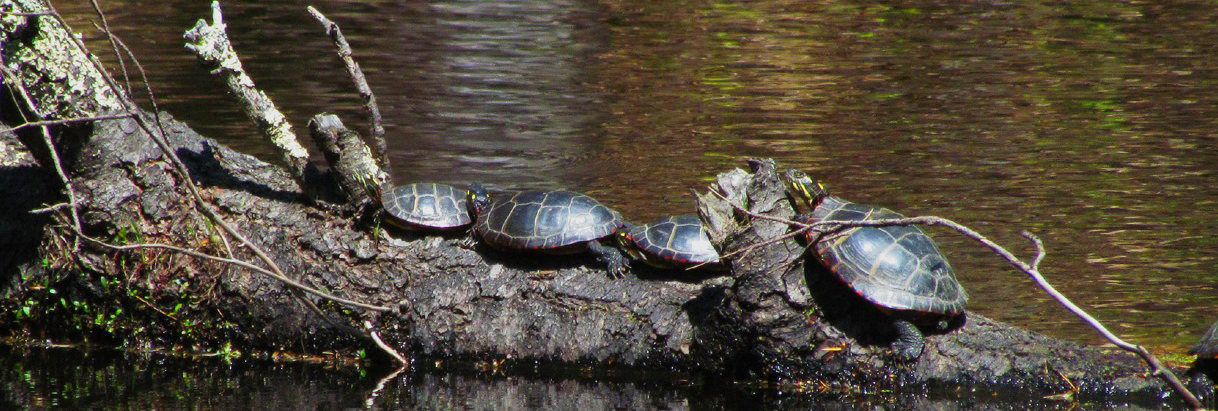TEACHER BACKGROUND- INVERTEBRATES
Background:
Invertebrates are animals that lack a backbone, such as insects, mollusks, protozoans, and worms. The small animals that live in a river can often tell much about the health of the river. As a general rule, the greater the number of species, the more diverse the river's habitats are, and the healthier the river is. A river with only a few species of invertebrates often indicates that only the most resilient species are able to survive.
With insects and other invertebrates, determining the exact species of specimens can be a difficult task. Even without determining the exact species, however, students will build a good appreciation for the diversity of aquatic invertebrates and will learn to identify some of the common groups.
The field work involved with invertebrate study will involve gathering water samples. Most of the work will occur back in the classroom when students will look at their specimens under a microscope.
Discussion:
What do scientists hope to learn by looking at the invertebrates that live in a river?
Suggested Resources or Web Search Topics:
How to prepare a slide for aquatic creatures.
http://www.greatscopes.com/act014.htm
Great Scopes also has directions for making a specimen collection net.
CHAPERONE CHEAT SHEET- INVERTEBRATES
In the field:
Help students gently collect water samples that contain invertebrates. Place specimens into the appropriately labeled containers by site. Collect swimming critters using a small net. Scrape algae and scum off rocks. Gather algae and collect the water that you squeeze out. Kick rocks at the bottom of the stream channel and collect the critters that float into a net held just down stream of where you kick. Use a jar to collect samples of water weeds. Collect amoebae by holding a jar upside down just above a muddy bottom. Slowly let the air escape, letting the top layer of muck get sucked into the jar.
Make sure water samples get safely back to school.
In the classroom:
Place a sample of river water on the sample tray of the discovery scope. View the sample through the discovery scope lens. Draw some of the things you see, making sure drawings go onto the appropriate data sheet. Is it an insect, mussel, snail, worm, or something else? Does it have obvious gills, eyes, legs, or mouth parts? Help students identify the specimens.
STUDENT EXPERIMENT- INVERTEBRATE WATER SAMPLE TEAM
Overview:
Invertebrates are animals that do not have a backbone or spine. Invertebrates come in many sizes, from microscopic (such as baby insects) to enormous (such as giant squid). The invertebrates in the river are mostly small and can easily fit in a hand or even a teaspoon. Most are visible to the naked eye, but trying to determine the exact critter often requires a microscope and a trained eye.
The invertebrates that live in the river are aquatic for at least part of their life cycle. Mosquitoes and dragonflies, for example, live in the air as adults, but lay their eggs in water. When the eggs hatch, the larvae (babies) live in the water. Other invertebrates are completely aquatic, such as mussels, crayfish, and snails.
The invertebrates that live in the river can tell scientists a lot about the health of the river. Some live in a wide range of conditions. Some live only in the cleanest, coldest water. Others can tolerate polluted water. The community of invertebrates that lives in a river often changes along the course of the river. The invertebrates that live in the small streams far inland might not live further downstream where the river gets wider and slower. Overall, a wide variety of invertebrates is a good sign of a river's good health, and a small variety of invertebrates often indicates problems. To understand the full picture, scientists obtain samples at different sites along the river, as well as different times of the year.
Focus:
How many different types (or species) of invertebrates are found along the river? Does this indicate that the river is healthy or not?
Materials:
__plastic and glass jars with lids, labeled Site 1, Site 2, etc. (at least two jars per site)
__fine-meshed nets
__spoon
__pencil
__data sheet
__shallow pan to place specimens in back in the class room
__discovery scope(s)
__pipette(s)
__microscope slides
__spring water or rainwater
Procedure:
Field:
1. Collect samples: (Each sampling technique might not work at all sites.)
Fill the jars for each site half full of river water. Leave one empty.
Place a few leaves of aquatic plants into a glass jar and label it "Keep water in jar".
If algae or sphagnum moss is present, squeeze and add the water that comes out in the jar.
Use a fine-meshed net to scoop up free-swimming invertebrates. Place them in a jar by turning the net inside out and dunking.
Scrape a few rocks or other hard surfaces with a spoon and place the scrapings into a jar.
Take an empty jar and turn it upside down in air. Hold the jar upside down while lowering it slowly into the water. Just before the jar touches the muddy bottom, slowly tip the jar to let the air out and let the water in.
Ask an adult to kick the rocky bottom gently to stir it up. Place a net just downstream of the kick site and collect what flows in.
2. When samples are collected, put lids back on jars. Make sure all equipment goes onto the bus.
Classroom:
1. After the field trip is over, gently pour samples (except the jar labeled "Keep water in jar") to shallow pans labeled Site 1, Site 2, etc.. (No lids... let the water have access to air.) Place the pans near a window so they can receive indirect sunlight. Add spring water or rain water to the samples if the river water evaporates. (Do NOT use tap water; it might contain chlorine or other chemicals.)
2. Locate the glass jar labeled "Keep water in jar" and look carefully at the jar walls. If any invertebrates are seen, collect them using a pipette, and make a slide.
3. In the shallow pan, look to see what invertebrates might be swimming or crawling. Collect what is seen using a pipette. (Students who have open sores or cuts on their hands should wear gloves.) Chances are good that sediment from the bottom will be sucked up into the pipette along with invertebrates. Hold the pipette upright for a few minutes to let the heavier particles collect in the tip. Squeeze the pipette bulb to place drops on a plate. Use a clean pipette to suck up one of the drops with the least amount of visible debris and place it on a microscope slide.
4. Observe samples on slides under low power and make sketches on Data Sheet 9. Add notes to help explain what cannot be drawn clearly. Use higher power to get more detail as needed. Does the specimen have eyes, legs, gills, a shell, mouth parts? Refer to invertebrate guide books to help identify the various invertebrates. Look for clues that the guides suggest. If and when an invertebrate can be positively identified, note the animal's name on the sketch sheet.
5. Wash hands after handling pond water.
Discussion:
How many types (species) of invertebrates were found?
How many could be positively identified?
How many live in the water full-time? Name an example.
How many live in the water part-time? Name an example.
Describe the strangest looking critter.
Based on the variety of invertebrates that were found, do you think the river is healthy? Why or why not?
Do you think the class obtained a sample of invertebrates that reflects the true variety of invertebrates? Why or why not?

